Journey to India
by Darla A. Meulemans, MA, CADC III, OMC | April 29th, 2019The Backstory
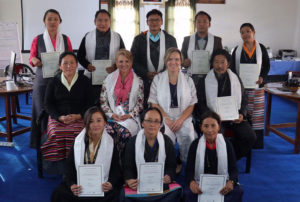 Nestled in a valley of the Himalayan Mountains in Northern India is a small Tibetan Colony called Bir, just 31 miles south of Dharamsala, Himachal Pradesh, India, the city of His Holiness the Dalai Lama and the Tibetan government in-exile. Bir is home to many Tibetans and several Buddhist Monasteries, but is also world-renowned for Paragliding. In November, 2018, Bir hosted the World Cup Qualifiers and was also a landing point for me and Virginia Rojas Albrieux, as we embarked upon a journey to support change in the Tibetan Children’s Village of Chauntra, neighboring Bir to the South.
Nestled in a valley of the Himalayan Mountains in Northern India is a small Tibetan Colony called Bir, just 31 miles south of Dharamsala, Himachal Pradesh, India, the city of His Holiness the Dalai Lama and the Tibetan government in-exile. Bir is home to many Tibetans and several Buddhist Monasteries, but is also world-renowned for Paragliding. In November, 2018, Bir hosted the World Cup Qualifiers and was also a landing point for me and Virginia Rojas Albrieux, as we embarked upon a journey to support change in the Tibetan Children’s Village of Chauntra, neighboring Bir to the South.
But this journey didn’t begin there. There’s quite a history of how this project came to be. Back in 2014, a team from the EEG Institute, including Siegfried and Sue Othmer, Evvy Shapero, Barbara Dalton-Taylor and Virginia Rojas Albrieux, traveled to Dharamsala, upon invitation by Minh Chau Le, who has extensive involvement with the Tibetan Community through the Snow Lotus Foundation. The purpose of this trip was to train the doctors of the Men-Tsee-Khang Clinic of Tibetan Medicine on how to use Neurofeedback for resolving trauma-related symptoms of the Tibetan refugees fleeing from Chinese torture and persecution in Tibet. Many had found their way to Dharamsala, and it was presumed that many would be suffering from PTSD. Neurofeedback could be used to alleviate their suffering. After a week of training, four complete Cygnet systems were left with the doctors so that they could carry on the work.
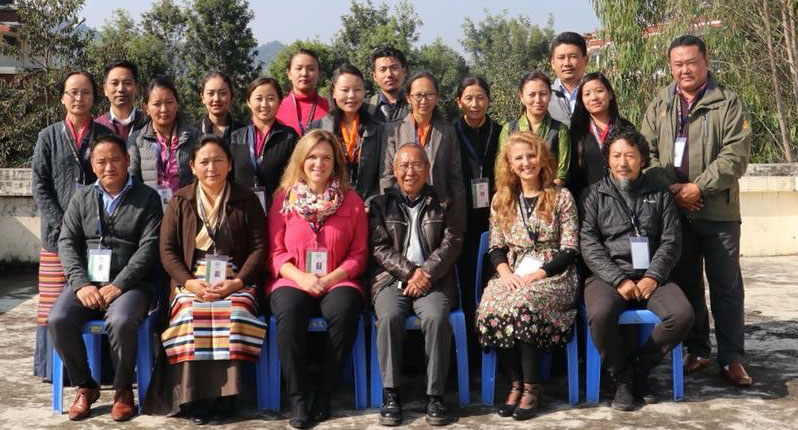 In 2015, Minh Chau Le, who had invited the initial group, asked Hanno Kirk and his wife to come to Dharamsala to attend the annual four-day Teaching of the Dharma by the Dalai Lama for South East Asian Buddhists. Minh and Hanno had a meeting with the doctors of the Men-Tsee-Khang Clinic to see how they had fared since their training the year before. Minh and Hanno found that the Clinic staff had barely used the equipment due to various practical, technical and cultural reasons. One reason may have been that the Chinese had sealed the Tibetan-Indian border, and few refugees were getting through any longer. Another may have been that the Buddhist culture has a somewhat different orientation toward the typical PTSD symptoms seen in the West. In the Buddhist culture, suffering is viewed as part of the path to enlightenment, so there may be a higher tolerance for the uncomfortable symptoms commonly associated with PTSD.
In 2015, Minh Chau Le, who had invited the initial group, asked Hanno Kirk and his wife to come to Dharamsala to attend the annual four-day Teaching of the Dharma by the Dalai Lama for South East Asian Buddhists. Minh and Hanno had a meeting with the doctors of the Men-Tsee-Khang Clinic to see how they had fared since their training the year before. Minh and Hanno found that the Clinic staff had barely used the equipment due to various practical, technical and cultural reasons. One reason may have been that the Chinese had sealed the Tibetan-Indian border, and few refugees were getting through any longer. Another may have been that the Buddhist culture has a somewhat different orientation toward the typical PTSD symptoms seen in the West. In the Buddhist culture, suffering is viewed as part of the path to enlightenment, so there may be a higher tolerance for the uncomfortable symptoms commonly associated with PTSD.
However, it is most likely that the Doctors at Men-Tsee-Khang were just so busy treating an extremely high patient volume with their existing skill set, that it was simply easier and much more practical to rely on traditional Tibetan medicine practices, rather than trying to implement the more time-intensive process of Neurofeedback training. Most of their patients arrived from long distances and were not prepared to stay long.
After His Holiness beckoned to Hanno during a break in the teaching in order to make his acquaintance, the three were invited to have a private audience with His Holiness. During this meeting, Hanno and Minh reported their findings, and suggested some recommendations for more general use with patients at the clinic and also for overcoming some of the practical and technical barriers mentioned by the doctors. His Holiness enthusiastically endorsed the recommendations. However, over the next year, the clinic doctors still were not utilizing Neurofeedback. It was at this time that it was suggested the focus be shifted to the Tibetan Children’s Village (TCV) Schools.
TCV is the largest welfare organization in India serving Tibetan refugees and is said to be dear to the heart of the Dalai Lama and his sister. They serve over 16,000 children in eight schools located in different regions of the country. In 2015, Hanno Kirk began discussions with Mr. Passang, the Principal of the TCV school at Chauntra and home of TCV’s Special Needs Program. Mr. Passang and his Lead Special Educator, Mr. Chime Dorjee, and School counselor Mr. Migmar, all expressed interest in using Neurofeedback to support students with various developmental conditions, learning disabilities, ADHD, or other psychological issues.
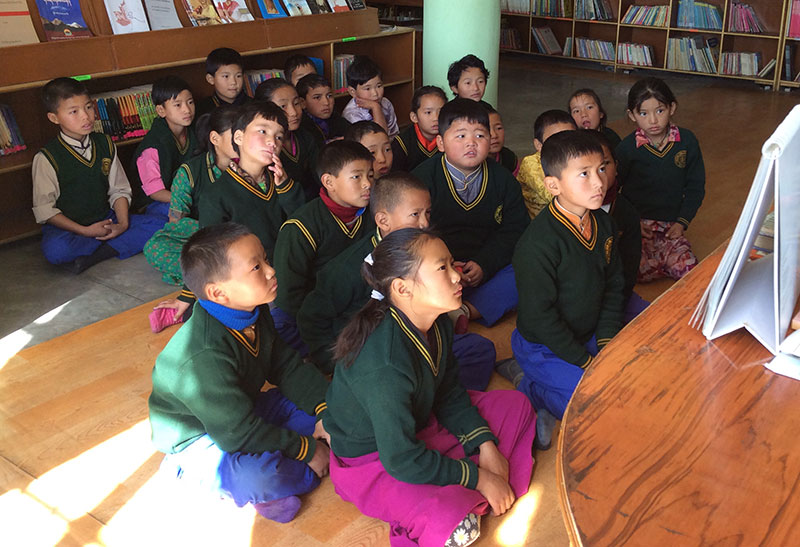
By fortuitous circumstance, Susan Itano, a Neurofeedback practitioner who was using neurofeedback with children at the Speech and Language Development Center in Buena Park California, heard about the efforts to make a connection with TCV and wanted to help. While traveling in India, she arranged to meet with the principal and counselors of TCV, and also with staff from the Pathseeker School in Dera, Amritsar, Punjab. Using the equipment from the Men-Tsee-Khang Clinic, Susan gave them a two-day introduction and demonstration of the Neurofeedback technology. It was received with enthusiasm by the attendees, who looked forward to using it with the children in their care to help them reach their highest academic, social and emotional potential.
The next step to further supporting the children at TCV was to find a way to bring two of the staff members who had received the introductory presentation at Amritsar to Woodland Hills to attend the formal introductory course. In response to an appeal for funds, our EEG community responded very generously, and it looked like everything was set for them to come to the course. Unfortunately, a junior consular officer at the US Embassy had refused to issue the necessary visas. The fear was that this project was just a ruse to get these folks over here, and then they would never leave. Once again, a shift in strategy was called for. If the counselors couldn’t come here, maybe instructors could go to India to deliver a full-scale introductory training over there. For the same travel budget, many more could be taught.
This brings us to the Clinical Summit in June 2018. Minh was sharing the status of the Tibetan Children’s Village project in the small discussion group that I was part of. She mentioned that Hanno Kirk was coordinating the project and trying to put something together for a team to travel to India in the Fall/Winter. I had goosebumps on my arms, and an image popped into my mind that I had started having as a teenager. This vision was of myself surrounded by dark-skinned children, clearly in a foreign land. I had imagined over the years that this was Haiti or Africa. I had always known I would go on a service trip of some sort at some point in my career. In that moment of hearing Minh, I knew the children in that image in my head were Tibetan children and perhaps Indian soil was the ground I envisioned around us.
Things seemed to start clicking in my head because after I first had that vision as a teenager, I started sending money to one Tibetan organization or another – always feeling completely drawn to this community. I mentored with a Buddhist Psychologist on the East Coast throughout my undergrad and graduate studies. He and his wife sponsored several Tibetan families and continue to do so to this day. In fact, when they heard about this trip that I would get to take, they donated money to the Brian Othmer Foundation to support our efforts. I didn’t even think through how I would possibly make this happen given that I have a toddler at home and have a part time private practice I’m responsible for. But I felt the call and I answered with “Yes, please may I join you?”
I was delighted to learn that Siegfried was putting together a teaching team and that I would be included to support Virginia Rojas Albrieux, who conducts courses in South America for EEG Info. I was also nervous because although I discuss the main concepts involved in ILF Neurofeedback Training with my one-on-one clients all the time, I would need to rise to the challenge of teaching these concepts to other practitioners in a clear and concise manner, with the additional potential barriers of language differences, culture, and technical obstacles.
Virginia and I dedicated several evening and weekend hours to online Zoom meetings where we developed a plan, and then we modified the Intro Course and Practicum curriculum and manuals to offer two tailored courses for the TCV staff: A Two-Day Brief Introduction to Neurofeedback for all the Counselors and Teachers from the eight TCV schools, and then a more intensive four-day Practicum for just the staff members from the two local schools with Special Needs kids. This smaller group would be the ones to implement NFB with students.
Virginia and I discussed how we would work together, who would be responsible for which portions of the training, but most importantly, how we would present concepts and conditions (ADHD, Attachment Disorders, medications, etc.) that may be familiar to Western cultures and practitioners in health-related fields, but may be unknown or even offensive to the Tibetan people. We composed numerous emails to correspond with the Principal of the School, and we coordinated with Kurt Othmer and his team to bring three Cygnet systems and all the supplies, to be sure that the equipment was up to date. We corresponded with Minh Chau Le in Vietnam, who had contact with the Men-Tsee-Khang clinic staff, to borrow equipment so we would have enough systems available for hands-on training of all the staff who wanted to provide NFB. Meanwhile, I reviewed the Intro course materials and brushed up on the concepts, since it had been some time since I had last taken the course myself. Nearly every waking hour was consumed by this project from the end of August until the end of October. There were so many details and so many unknowns.
Beginning of the Journey
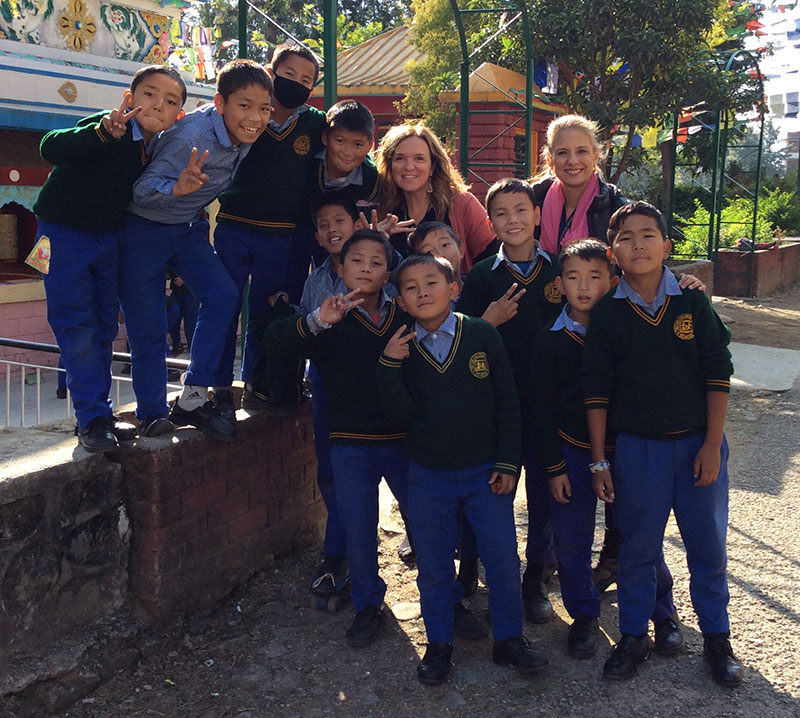 Virginia and I had coordinated our schedules to meet up in India a few days before we were due to begin set up for the courses. This time proved to be invaluable as it fostered a connection that would allow us to facilitate these courses with an ease and flow that felt to us as if we had been working together for years. When we arrived in Dharamsala, we were welcomed by Gosa Lama, a Buddhist monk who is a dear friend of Minh Chau Le. He brought us to his Holiness’ Temple and the Tibetan Museum. He also shared with us some of the history of the Tibetan refugees, allowing us to understand what these people have survived, which served to further open our hearts to TCV’s mission to promote self-reliance amongst the refugee children, so that they may meaningfully contribute to their community.
Virginia and I had coordinated our schedules to meet up in India a few days before we were due to begin set up for the courses. This time proved to be invaluable as it fostered a connection that would allow us to facilitate these courses with an ease and flow that felt to us as if we had been working together for years. When we arrived in Dharamsala, we were welcomed by Gosa Lama, a Buddhist monk who is a dear friend of Minh Chau Le. He brought us to his Holiness’ Temple and the Tibetan Museum. He also shared with us some of the history of the Tibetan refugees, allowing us to understand what these people have survived, which served to further open our hearts to TCV’s mission to promote self-reliance amongst the refugee children, so that they may meaningfully contribute to their community.
The next day we were set to travel several hours through the winding foothills and valleys of the Himalayas, in and out of little Indian Villages, on dirt roads. We arrived later than we had planned due to some challenges we had acquiring a permit to travel to the Tibetan Colony. We were greeted by the Assistant Headmistress, Madame Tensin Dolma, and the Head of the Special Needs School, Mr. Chime Dorjee. Mr. Passang, the Principal, was unable to be there for the week due to another meeting in New Delhi, but he left us in very capable hands.
We quickly went to work setting up the room that they had prepared especially for our class in one of the buildings that previously housed children. The classroom space had been a boys’ dormitory, and across the hall were the girls’ dorm and staff quarters. We were expecting 21 attendees for the Two-Day Brief Introductory Course. They would be coming from 8 different schools, some traveling for three days to get there. Those out of town attendees would be staying in the “girl’s dorm” and “staff quarters” across the hall from where we would be teaching. Additionally, the President of all of the TCV schools would be driving the same route we had taken the first day in order to join us. He had been following our emails with the Principal and had seen our Course Objectives and personally emailed us asking if we would start slightly later so he could attend, as he was very interested in the potential of Neurofeedback for ALL the students, not just those with special needs.
As we set up the room, we were met with various technical challenges, but our hosts were very accommodating, bringing in other staff with various expertise to get everything working. Since the two-day course had so many attendees, we would only be able to provide a few live demonstrations, as opposed to having all attendees experience the training, as occurs in the Intro Courses elsewhere in the world. However, we were already anticipating needing to set up systems to work for the 4-day practicum, so we were updating software on computers from Men-Tsee-Khang, checking the status of the sensors, and preparing tactile devices. Instead of the build-a-bear stuffed animals ordinarily used for tactile feedback, we brought potholders into which we stuffed the mechanical devices. However, we also followed the suggestion of the Head of the Special Needs School and inserted some of the devices into the stuffed animals from the dorms.
While we were sewing these up, setting up the computers and sipping Marsala tea, we learned from visiting with the staff that they really take time and care to know every child’s individual skills and limitations, and to help them find a path for personal development so that they can meaningfully contribute to their community. We were also delighted to hear that everyone that would be attending the courses had Master’s degrees in either special education, social work, psychology, or physical therapy. In fact, the Head of the Special Needs School was himself raised at TCV and then went on to get a double master’s in social work, medical psychiatry and special Ed. He had attended the brief intro last year with Susan Itano and was extremely enthusiastic to learn more this week and be able to implement neurofeedback upon our departure.
We also learned, from conversations the day before class began, that the attendees are all very knowledgeable about the types of health challenges and conditions that can be helped with neurofeedback. We learned that they struggled to intervene with conditions such as Bipolar Disorder, epilepsy, cerebral palsy, learning disabilities, autism, cutting and self-injurious behavior, aggressive behavior, ADHD, Trichotillomania, as well as binge eating and purging. Hearing these things brought a sense of relief because up until these conversations, we had no idea if the course content and materials we had prepared would be understood and relevant to the attendees.
Leaving the classroom our first night of set-up, we heard the beautiful voices of the children as they sang their prayer before dinner. We would get to hear this several times each day over the course of the next week. When we got to meet some children that first evening, they all had big smiles and greeted us with the traditional hands together and bow. Instead of the “Namaste” we had heard in the Indian Villages, we heard “Tashi Delek.” The headmistress told us that they had been preparing the children for our visit and everyone was very excited. We were struck by the order that prevailed, and the level of independence shown by the children— they were so well behaved!
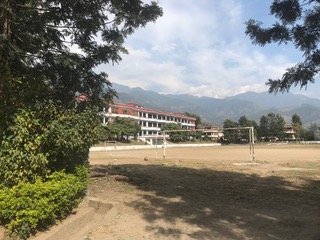 There were over 800 children at Village of Chauntra, ranging in age from 5 to 14. The Village is enclosed, much a like a gated community, with classrooms, staff housing and dorms on the perimeter of the property, and the track and soccer field in the center. Each home has a community garden where they grow some of the vegetables they serve at meals. Food arrives two days each week and consists mostly of vegetables, lentils and rice. They have plans to obtain enough cows to provide milk for the children. All meals are vegetarian and prepared by the house mother, who may have up to 80 children in her care. This may sound like chaos, but the children were well mannered and self-reliant (doing their own laundry and storing their bedding each day). Clearly the structure of the environment, the Buddhist practice and the loving care had fostered a peace and resilience amongst the children.
There were over 800 children at Village of Chauntra, ranging in age from 5 to 14. The Village is enclosed, much a like a gated community, with classrooms, staff housing and dorms on the perimeter of the property, and the track and soccer field in the center. Each home has a community garden where they grow some of the vegetables they serve at meals. Food arrives two days each week and consists mostly of vegetables, lentils and rice. They have plans to obtain enough cows to provide milk for the children. All meals are vegetarian and prepared by the house mother, who may have up to 80 children in her care. This may sound like chaos, but the children were well mannered and self-reliant (doing their own laundry and storing their bedding each day). Clearly the structure of the environment, the Buddhist practice and the loving care had fostered a peace and resilience amongst the children.
Monday morning we began our Brief Intro course with 17 participants. We were both struck by the ease and rapport amongst the group, and depth of conversation and dialogue. We learned that many of the staff at this training were once students at TCV and now serve the community. We prepared the course to be interactive, in addition to providing some basic concepts about self-regulation and calming and stabilizing the nervous system. We introduced core concepts such as arousal and activation, discussed the lobes of the brain and basic functions, and discussed starting placements and training frequency. As a whole group, we had the participants share what some of their biggest challenges were in terms of working with the students. We then designed a small group activity where the participants would take a set of symptoms and presenting concerns and discuss which basic placements would be part of the training plan, and where they would start, at either T4-P4, T3-T4, or both. Again, we were surprised and impressed that they seemed to grasp the concepts we were presenting readily, and there was a comfort amongst the group in sharing and asking questions.
At the lunch break, the Principal shared his hope to acquire two additional laptops to pair with the NeuroAmps made available from MTK, so each of the TCV schools represented at the course could have a trained person, as well as a system available for staff and students. This aspiration, on top of the presentation of the material, got everyone so excited during the first day that 6 additional attendees asked special permission to stay on for the 4-day Practicum. We were so delighted to have a full class with representation from 6 different TCV schools instead of just the two originally planned. This presented an issue of having enough computers but due to the graciousness of the MTK clinic staff, we were able to borrow two of their laptops that were Cygnet-ready, only needing updates.
The other surprise from the first class was that mid-morning of the first day, a very enthusiastic gentleman showed up outside the door. The Assistant Head Mistress greeted him; they had a brief dialogue, and then the man left. At the break, Madame Dolma asked permission for this man to join the course. He was a Physical Therapist who was raised at TCV, who had been a student of Mr. Chime’s, and who was now working for the Tibetan Clinic in the neighboring town. He had heard about the course, and being familiar with Neurofeedback he requested permission to join our group. It turns out, this very bright and eager young man, who reads whatever he can get his hands on and searches the internet with an unquenchable thirst for knowledge, was a big fan of Siegfried’s writing! He had missed the first morning, where we presented the evolution of ILF NFB while we shared a photo of Sue, Siegfried and Kurt, and mentioned the Brian Othmer Foundation as sponsor to these courses and the equipment. He practically fell over when we said that Sue and Siegfried were our mentors. Virginia also shared with him about the trip in 2014 and showed a picture of the 2014 teaching team with the Dalai Lama and his eyes grew big.
The Four-Day Practicum
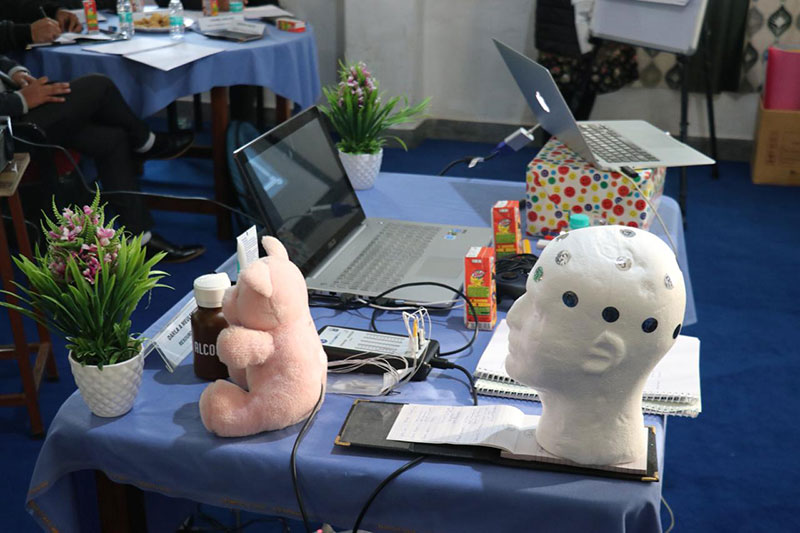
Virginia and I felt so good about how much we were able to cover in the two-day course that heading into the 4-day Practicum we knew we would have more time for hands-on experience, since we had already covered so much of the didactic material. We decided to schedule a few students to come in for sessions that we would supervise, in addition to the two sessions each day for each staff member. This would offer some great experiential learning opportunities. TCV Chauntra, which houses the largest number of special needs children of all of the eight villages, had several children with Cerebral Palsy, while others experienced Autism, mental retardation, and some other undiagnosed genetic conditions. We were told by the course attendees that when the students come to TCV, they rarely have any documented family or medical history, so the staff must rely on observation and current presenting symptoms to evaluate the needs of each student. They also rarely have any formal testing in terms of learning differences.
We asked the staff who were most familiar with the students in the Special Needs program to present the cases they were considering to the group. The group then determined starting placements and came up with a treatment plan based on the symptom profile. Of course, they picked their two most difficult cases – for whom they felt at a loss of what to do. One of these students was an 18-year-old with an undiagnosed developmental disorder and likely a genetic condition. She had been with the school for about ten years, and had little contact with her family. She presented with sleep disturbance, enuresis and encopresis, emotional regulation issues, and various behavioral concerns. The other student they selected was an 8-year-old boy with Autism, and various sensory processing, emotional regulation and behavioral issues. A third student was selected from their mainstream program because he struggled with academics and conduct problems, and although he was very smart, they felt he wasn’t reaching his potential.
The first session with the young boy with autism and a history of aggression was complete chaos. He entered the room screaming, ran around all the tables tripping over wires – a tornado. We responded quickly, as did the group of practitioners. We corralled him to one of the stations and began working to get him hooked up. He didn’t want to be touched, pulled the sensors off several times and was completely disinterested in looking at the screen so even distraction tactics during hook up failed. Of course, he escalated during this time, so we gave him a few minutes to calm down, re-strategized and tried again. This time we got him hooked up, but the signal quality was terrible. We realized he had damaged one of the sensors, so we quickly replaced it and resumed the session.
The group of participants totally rallied to assist and one person who this boy is familiar with (the Head Special Ed Teacher) had to restrain him in the beginning, but within a few minutes, this boy relaxed and allowed the session to unfold. We used InnerTube with the engine volume loud and no music, plus the tactile device, since he would not engage with the visual feedback. After the first session, he was making some eye contact with all of us, sitting quietly and still. The House Mother reported that he was much calmer and that he slept through the night, which wasn’t typical for him. The next day he entered the training room calmly – we actually didn’t even notice he had arrived because he was so quiet. We got him hooked up with no problems and continued our work. After just one session with each of these students, positive changes were observed by the House Mothers and also the course attendees, the Headmistress, and us. They all were much calmer, had improved sleep, with no report of teeth grinding or encopresis. There were many more stories and changes being witnessed by staff who were each doing two sessions a day for themselves, but we will just say that all went very well, and we couldn’t have been more pleased upon completion of our week.
Most touching for us as facilitators was that the staff had planned a special closing ceremony for us where they presented us with gifts, sang songs, and shared with the group some final words about how the course had impacted them. They all had tears in their eyes and were so filled with gratitude, not just for the possibility this work can offer to their students, but for the changes they already witnessed in themselves after having 7 personal ILF sessions plus one synchrony session. One woman, a science teacher at TCV for 20 years, was choked up as she said she now wants to have a career change and be a full-time neurofeedback practitioner so she can help more students. We left feeling confident that the work we did would continue to unfold because everyone was so enthusiastic about moving forward and learning more. For such purpose, we established a WhatsApp group for case consultation and agreed to set up group phone/web consults, as needed.
The Follow-up
Since returning to the States, we have maintained contact with the group. There was only about one month between the time of our departure and the beginning of their two-month winter break, where most of the students and the staff leave the property. During those four weeks, the equipment was distributed to some of the other schools, and a few sessions were run. Since March, Neurofeedback has been included in the school time table in the Special Needs Section at TCV Chauntra, with three teachers using neuofeedback with their students two periods every week, or more as the opportunity presents itself. Two other schools have also gotten underway, and more will do so soon.
In summary, the eight days we spent working at TCV had its challenges – including technical ones with the power going on and off frequently, which would kick us out of Cygnet, and various environmental challenges of being a third world country. Living arrangements were spartan, shall we say. However, our gracious hosts, the enthusiastic staff, the sweet children, the beautiful mountain views, the camaraderie between colleagues, and the joy of witnessing the transformations ILF NFB supports, made this trip an incredibly memorable and life-changing experience. We are most grateful to all those who contributed to the efforts to bring this to fruition, and especially to the Othmers, for carrying the vision of sharing NFB across the globe and entrusting us with this responsibility and opportunity to serve. Namaste.





